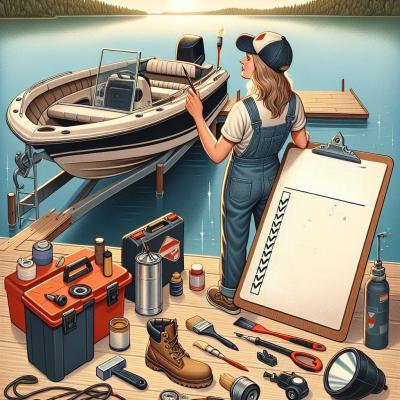Keeping your boat in top shape not only prevents unexpected breakdowns but also optimizes performance and fuel efficiency. Moreover, a well-maintained boat offers peace of mind, especially when you have boat insurance as an added layer of protection. Insurance can save you from significant financial loss resulting from accidents, damages, or other unforeseen events.
In this article, we will cover a comprehensive checklist for beginner boat maintenance. We'll delve into crucial tips on choosing eco-friendly materials, regular upkeep, fuel efficiency, waste disposal, and much more. By the end, you'll be well-equipped with the knowledge to keep your boat running smoothly and sustainably.
Understanding Your Boat
Know your boat's make, model, and specifications
Before diving into maintenance, it's crucial to know your boat inside and out. Start by familiarizing yourself with your boat's make, model, and specifications. This information is typically found in the owner’s manual or can be obtained from the manufacturer.
Understanding these details gives you insight into the specific needs and potential issues your boat might face. It also aids in sourcing the correct replacement parts and materials, ensuring you're always prepared for any maintenance or repair tasks.
Importance of reading the owner's manual
The owner's manual is your boat's bible. It contains essential information on operation, maintenance, and troubleshooting. Reading it thoroughly can prevent many common mishaps and costly repairs.
The manual also provides recommended service intervals and schedules, helping you stay on top of regular maintenance tasks. Make it a habit to consult the manual whenever you're unsure about any aspect of your boat's operation or upkeep.
Familiarize yourself with essential boat parts and systems
Knowing the key parts and systems of your boat is another critical step in boat maintenance. This includes understanding how the engine, electrical systems, plumbing, and navigation equipment work.
Spend time exploring your boat and identifying these components. You can refer to diagrams in the owner's manual or seek guidance from more experienced boaters. This knowledge will be invaluable when performing checks and identifying issues.
Pre-Departure Checklist
Hull and Exterior Inspection
Before you head out on the water, it’s crucial to inspect the hull and exterior of your boat. Look for any signs of damage, such as cracks, blisters, or areas of abrasion. These could potentially lead to more significant problems if left unchecked.
Also, ensure that all fittings and attachments are secure. This includes checking the condition of the hull and the integrity of any mounted accessories or equipment. A thorough exterior inspection will ensure that your boat is seaworthy and safe for your trip.
Check Fuel and Oil Levels
One of the most important pre-departure steps is to check your boat’s fuel and oil levels. Running low on either can lead to inconvenient and potentially dangerous situations. Ensure that your boat has enough fuel for the entire journey, with some reserve in case of emergencies.
Additionally, check the oil level and top it up if necessary. Look for any signs of leaks, which could indicate underlying engine issues that need to be addressed before you set off.
Inspect the Propulsion System
Make sure to inspect your boat's propulsion system, including the engine and propeller. Look for any visible damage or wear and tear. If you have an outboard motor, ensure that the propeller is free of debris and rotates smoothly.
Check that all connections are secure and test the throttle and steering system to confirm they are functioning correctly. This step helps prevent mechanical failures while you are out on the water.
Ensure All Safety Equipment is On Board
Safety should always be a top priority. Verify that all required safety equipment is on board and in good working order. This includes life jackets for all passengers, fire extinguishers, flares, and first aid kits.
Additionally, ensure you have a working horn or whistle, throwable floatation devices, and a radio or other means of communication. Double-checking these items can make a critical difference in an emergency.
Verify Weather Conditions and Route Planning
Before embarking on your trip, it’s essential to verify the weather conditions and plan your route. Check the latest weather forecasts and be aware of any warnings or advisories. Sudden changes in weather can significantly impact your journey, so be prepared to adjust your plans if needed.
Additionally, map out your route and share your plans with someone onshore. Having a clear route and being aware of potential hazards or navigational challenges will help ensure a smoother and safer boating experience.
Engine Maintenance
Regular Oil Changes
Keeping up with regular oil changes is crucial for maintaining your boat’s engine. Just like with a car, fresh oil ensures that the engine runs smoothly and reduces the risk of overheating.
Consult your owner’s manual for the recommended oil change intervals. Depending on how often you use your boat, this could range from every 50 to 100 hours of engine operation. Always use the type of oil specified by the manufacturer for optimal performance.
Inspect and Replace Fuel Filters
Fuel filters play a vital role in preventing contaminants from entering the engine. Over time, these filters can become clogged, resulting in poor engine performance or even damage.
It's essential to inspect and replace fuel filters regularly. Make it a part of your routine engine maintenance to check for any signs of dirt or wear. Replacing fuel filters as needed will help maintain the efficiency and longevity of your engine.
Check Cooling System and Water Intake
Ensuring that your boat's cooling system is functioning correctly is another critical maintenance task. An overheated engine can lead to serious damage and costly repairs.
Regularly check the cooling system, including the coolant levels and hoses, for any leaks or blockages. Also, inspect the water intake for debris or other obstructions that could impede the flow of cooling water. Keeping the cooling system in good shape will help prevent overheating issues.
Battery Care and Maintenance
Your boat’s battery is the heart of its electrical system. Proper battery care and maintenance are essential for reliable engine starting and operation.
Check the battery terminals for corrosion and clean them as needed. Ensure that the battery is properly charged and securely fastened in its compartment. Regularly inspect the battery’s condition and replace it if it shows signs of wear or decreased performance.
By following these engine maintenance tips, you’ll keep your boat’s motor running efficiently and help prevent unexpected breakdowns while out on the water.
Hull and Deck Maintenance
Clean and Wax the Hull Regularly
A clean hull is crucial for maintaining your boat’s performance and appearance. Regular cleaning helps prevent the buildup of algae, barnacles, and other marine growth that can affect your boat's speed and fuel efficiency. Use a mild, non-abrasive cleaner that’s safe for your boat’s surface and the environment.
Waxing the hull after cleaning adds an extra layer of protection against UV rays and saltwater corrosion. It also makes future cleanings easier. Aim to wax your boat at least once or twice a season to keep it looking sharp and well-protected.
Inspect for Signs of Damage or Wear
Regular inspections of the hull and deck can help you catch small issues before they become big problems. Look for cracks, blisters, or any areas where the gel coat appears damaged or worn. Pay special attention to the waterline, as this is where most wear and tear occurs.
If you find any cracks or blisters, address them promptly to prevent water from seeping in and causing further damage. Consult a professional for any repairs that you’re not comfortable handling yourself, as improper repairs can lead to more issues down the line.
Maintain Deck Hardware and Fittings
Your boat’s deck hardware and fittings, such as cleats, rails, and stanchions, require regular maintenance to ensure they remain secure and functional. Loose or corroded fittings can compromise the safety and integrity of your boat. Inspect all hardware for signs of rust, corrosion, or wear and tighten any loose screws or bolts.
Applying a marine-grade lubricant to moving parts can help prevent corrosion and keep everything operating smoothly. Make it a habit to inspect and maintain both the hull and deck hardware regularly to ensure your boat stays in top condition.
Electrical Systems Check
Inspect Wiring and Connections
Maintaining your boat’s electrical systems begins with a thorough inspection of the wiring and connections. Over time, wires can become corroded, brittle, or damaged, which may lead to electrical failures or safety hazards.
Carefully examine all visible wiring for any signs of wear, fraying, or corrosion. Pay particular attention to areas that are exposed to the elements or prone to moisture. Ensure that all connections are tight and secure to prevent loose wires that could cause short circuits.
If you notice any damaged wiring, replace it promptly. Using marine-grade wire and connectors is essential as they are designed to withstand the harsh conditions of the marine environment, ensuring durability and safety.
Test Navigation Lights and Other Electrical Components
Functional navigation lights are critical for safe boating, especially when operating during low-light conditions or at night. Regularly test all navigation lights to ensure they are working properly. This includes the bow, stern, and anchor lights, as well as any additional lighting such as deck or cabin lights.
Additionally, check other essential electrical components such as the horn, GPS, depth sounder, and communication systems. Ensure that each device powers on and operates correctly. Keeping these systems in good working order is vital for both navigation and safety.
Maintain and Test Bilge Pumps
Bilge pumps play a crucial role in keeping your boat dry and preventing water from accumulating in the bilge area. Regular maintenance and testing of bilge pumps are necessary to ensure they function when needed.
Inspect the bilge pump for any signs of damage or debris that could impede its operation. Clean the pump and its filter to maintain efficiency. Ensure that the pump's wiring and connections are secure and free from corrosion.
Test the bilge pump by activating it manually and verifying that it can successfully remove water. Make it a habit to test the bilge pump routinely, especially before setting out on longer trips, to ensure your boat stays safe and dry.
Sails and Rigging (For Sailboats)
Inspect Sails for Tears and Wear
Regular inspection of your sails is crucial for maintaining their performance and extending their lifespan. Examine the sails for any tears, fraying, or signs of wear, particularly around high-stress areas such as the corners and along the seams.
If you spot any damage, repair or replace the affected sections promptly to prevent the problem from worsening. Proper sail care ensures your boat remains efficient and safe while sailing.
Check Rigging and Tension of Stays and Shrouds
The rigging system, which includes stays and shrouds, plays a vital role in supporting the mast and sails of your boat. Regularly checking the tension of the rigging can prevent structural failures and enhance your boat's sailing performance.
Inspect the rigging for any signs of corrosion, wear, or fatigue, and adjust the tension as needed. Maintaining proper rigging tension helps ensure your boat’s stability and safety on the water.
Regularly Lubricate Moving Parts
Lubrication is essential to keep the moving parts of your sailboat’s rigging system operating smoothly. Regularly apply a marine-grade lubricant to components such as blocks, winches, and furlers. Proper lubrication reduces friction and wear, prolonging the life of these critical parts.
By incorporating regular lubrication into your maintenance routine, you can enhance the overall performance of your sailboat and avoid untimely breakdowns.
Interior Upkeep
Clean and Ventilate the Cabin Area
Maintaining a clean and well-ventilated cabin is essential for both comfort and hygiene. Start by regularly cleaning all surfaces, including countertops, floors, and storage areas. Use cleaning products that are safe for the marine environment to avoid harmful runoff.
Proper ventilation helps prevent mold, mildew, and unpleasant odors. Open windows, hatches, and use portable fans if necessary to enhance airflow. Maintaining good air circulation will keep the cabin environment healthy and more enjoyable for everyone on board.
Check Plumbing and Water Systems
Your boat's plumbing and water systems need regular attention to ensure they function correctly. Inspect pipes, hoses, and fittings for any signs of leaks or corrosion. Replace any damaged components promptly to prevent water damage and maintain system integrity.
Also, check the condition of your water tanks and ensure they are clean and free of contamination. Regularly flushing and sanitizing the system can help maintain water quality, providing safe and reliable water usage while on board.
Inspect and Maintain Upholstery and Fixtures
The upholstery and fixtures inside your boat contribute to the overall comfort and aesthetics. Regularly inspect cushions, seats, and mattresses for any signs of wear or damage. Clean fabric surfaces using appropriate marine-grade cleaners to remove stains and dirt.
Additionally, check all interior fixtures such as lights, cabinets, and hardware. Ensure they are securely fastened and functioning correctly. Keeping the interior in good condition not only enhances your boating experience but also helps maintain the value of your vessel.
Seasonal Maintenance
Winterizing Your Boat
Preparing your boat for winter is crucial, especially if you won’t be using it during the colder months. Start by thoroughly cleaning the boat, both inside and out, to remove any dirt, salt, and grime. This helps to prevent corrosion and mold growth.
Next, drain all water systems, including the engine, pipes, and holding tanks, to prevent freezing. Add antifreeze to the engine and plumbing systems as an extra precaution. Remove any electronics, personal items, and soft furnishings to store them in a dry, safe place.
Cover your boat with a high-quality cover to protect it from harsh weather conditions. Perform a final inspection to ensure everything is secure and in good condition before the winter season sets in.
Preparing for the Summer Season
As warmer weather approaches, it’s time to get your boat ready for summer adventures. Start by inspecting the hull for any damage or wear that may have occurred over the winter. Clean and wax the hull to restore its shine and offer protection against UV rays.
Reinstall any electronics and personal items that were removed, and ensure all systems are functioning correctly. Check the engine, fuel, and oil levels, and perform any necessary maintenance tasks such as oil changes and filter replacements.
Inspect the sails, rigging, and safety equipment to ensure they are in good condition. Finally, stock up on essentials like life jackets, flares, and first aid supplies to guarantee a safe and enjoyable boating season.
Special Considerations for the Australian Climate
Boating in Australia presents unique climate challenges that require special attention. The intense sun and heat can cause damage to your boat’s surfaces and systems. Use UV-resistant materials and covers to protect your boat and consider installing sunshades for added protection.
During the dry season, ensure your boat's cooling systems are functioning efficiently to prevent overheating. Regularly check the water levels and filtration systems to avoid issues caused by debris and sediment.
In tropical and subtropical regions, be mindful of the potential for cyclones and extreme weather. Have a plan in place for securing your boat or moving it to a safer location during severe weather events. By taking these considerations into account, you can keep your boat in top condition year-round in the Australian climate.
Conclusion
Regular boat maintenance is the cornerstone of a safe and enjoyable boating experience. By following the comprehensive checklist provided, you can ensure your vessel remains in peak condition, ready for every adventure on the water.
Adhering to routine maintenance tasks not only extends the life of your boat but also optimizes its performance and fuel efficiency. Keeping up with these crucial steps prevents unexpected issues and provides peace of mind, knowing your boat is well-cared for.
We also cannot overstate the benefits of having comprehensive boat insurance. It offers financial protection against accidents, damages, and other unforeseen events, making it a valuable addition to your boat maintenance regimen.
Now it's your turn! We invite you to share your own experiences, tips, and suggestions in the comments below. Let's connect as a community of boating enthusiasts, all committed to maintaining our vessels and enjoying safe, smooth sailing!
Last updated: Thursday 16th May, 2024









